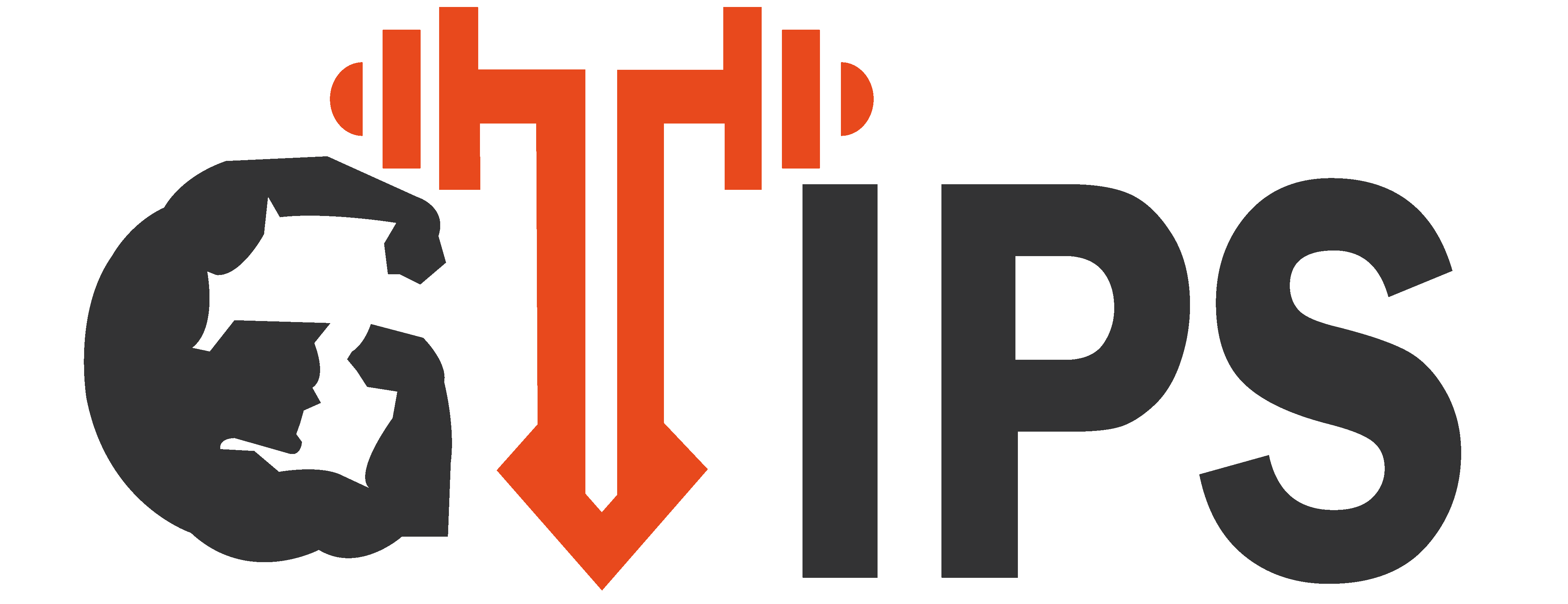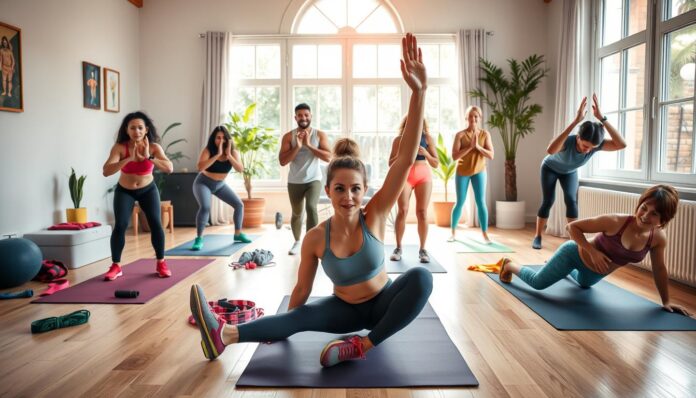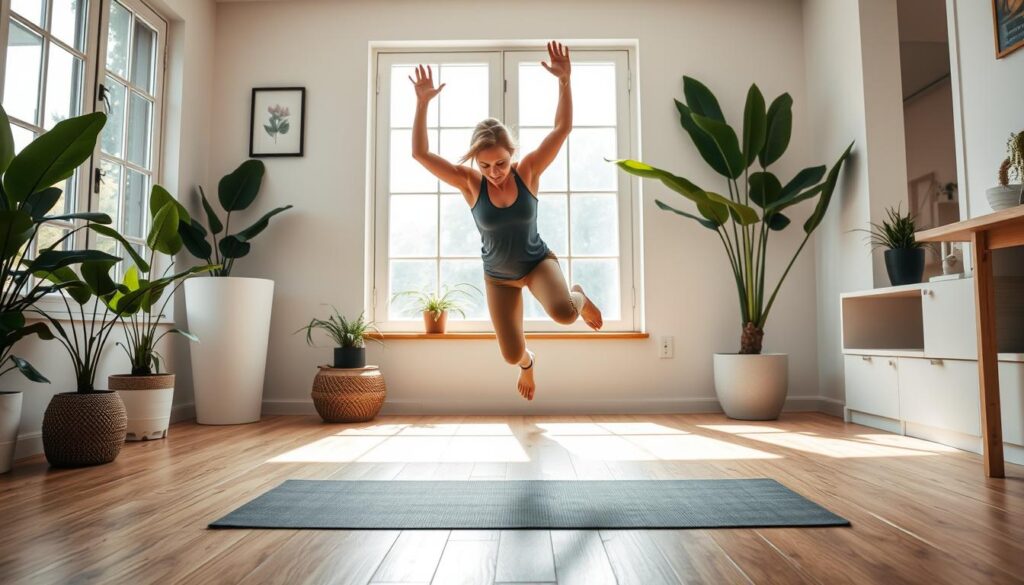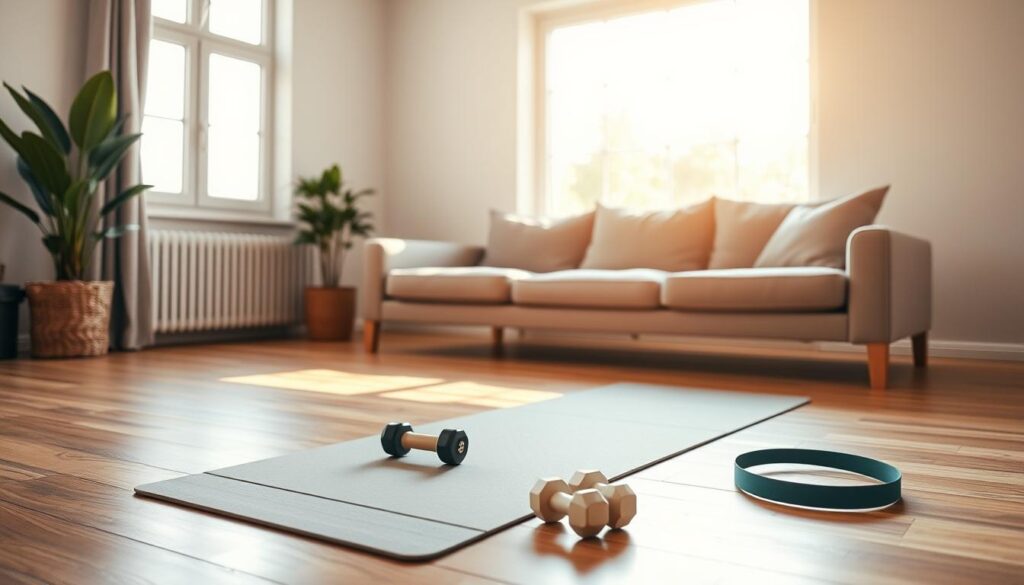Are you tired of gym membership fees and the hassle of going to a crowded gym? You can transform your body with effective home workouts that need no equipment. Use bodyweight exercises to build strength, burn fat, and boost flexibility – all from your living room.
No more excuses about not having time or gym access. Home workouts are super convenient, affordable, and can be done anytime, anywhere. Find out how to stay fit and healthy without spending a lot or wasting your time.
Key Takeaways
- Unlock the power of bodyweight exercises to build strength and burn fat at home
- Eliminate the hassle and cost of gym memberships with convenient home workouts
- Improve flexibility and overall fitness without any equipment
- Save time and money by exercising in the comfort of your own living space
- Discover simple yet effective home workout routines to get fit fast
Why Home Workouts Are the Future of Fitness
The pandemic changed the fitness world a lot. Now, home workouts are all the rage. They’re perfect for those who want to stay fit without leaving their house.
Benefits of Working Out at Home
Home workouts have many perks. They save money and time, as you don’t need a gym membership. Plus, you can work out whenever you want, making it more personal.
Time and Cost Efficiency
Home workouts save you time because you don’t have to travel. A short 20-minute session can be very effective. This is much cheaper than going to the gym, where you spend a lot of time waiting.
Convenience Factors
Working out at home means you don’t have to share equipment. You can focus on your own fitness goals without interruptions. It’s also a great way to build confidence, which is important for beginners.
Home workouts are becoming the norm in fitness. They offer a flexible and easy way to stay healthy and fit.
“The pandemic has accelerated the rise of home workouts, with 56% of respondents staying fit in their living spaces.”
Essential Warm-Up Routine for Home Exercise
Getting your body ready with a good warm-up is key for safe and effective home workouts. Whether you’re doing minimal space workouts or no-gym workouts, spend 5-10 minutes warming up. This helps activate your muscles and gets your heart rate up before your main workout.
Begin with simple dynamic movements like marching in place and arm and leg swings. Also, do assisted bodyweight squats and countertop push-ups. These movements will get your blood flowing and prepare your joints and muscles for harder exercises.
For a more challenging warm-up, try adding:
- Jump rope
- Jumping jacks
- Bodyweight squats
- Lunges
- Push-ups
Adding exercises like planks, bird dogs, and low lunges can warm up your core, back, and lower body. Hold each exercise for 45-60 seconds to fully engage the muscles.
Even at home, warming up is vital to prevent injuries and boost your workout performance. Make sure to get your body ready before starting your minimal space workouts or no-gym workouts.
No Equipment Home Workouts for Beginners
Staying fit at home is easy and affordable. You don’t need a gym or fancy gear. Simple bodyweight exercises can help you get stronger and fitter from your living room. These workouts are great for beginners or anyone wanting to add home strength training to their routine.
Basic Bodyweight Circuit
Start with a basic bodyweight circuit that works many muscles. This circuit includes:
- Assisted Bodyweight Squats – 20 reps
- Knee Push-Ups – 10 reps
- Dumbbell Rows (using household items) – 10 reps per arm
- Knee Planks – 45 seconds
- Walking Jacks – 30 reps
Do 2-3 sets of this circuit, resting for 1 minute between each. Focus on proper form to avoid injury and get better results. As you get stronger, you can make the exercises harder.
Proper Form Guidelines
It’s important to do these exercises right to avoid injury and get the best results. Keep your core tight, movements smooth, and breathe evenly. This will help you get the most out of your workout.
Beginner-Friendly Modifications
If you’re new to working out at home, don’t worry! You can adjust these exercises to fit your level. Try wall push-ups instead of knee push-ups, use a chair for squats, and start with shorter plank holds. The goal is to build a solid base before increasing the challenge.
“Even with just a few minutes a day, you can effectively tone muscles and achieve six-pack abs at home.”
High-Intensity Interval Training at Home
If you want to burn fat and boost your heart health at home, try high-intensity interval training (HIIT). These workouts are fast and don’t need any equipment. They mix intense exercise with short breaks, pushing your body and mind hard.
Start with simple exercises like burpees, mountain climbers, and jump squats. Do 20 reps of each, then rest for 2 minutes. Keep going for several rounds to really get your heart racing. These workouts are quick, lasting only 20-30 minutes, perfect for those with tight schedules.
For the best results, focus on doing each exercise right. Keep your core tight, move smoothly, and don’t rush. Learning proper form not only boosts your fitness but also keeps you safe from injuries.
Ready to level up your home workouts? Add no equipment HIIT routines to your routine. Get ready to sweat, challenge yourself, and reach new heights from your own space.
“HIIT workouts are a game-changer for anyone looking to burn fat and build endurance at home. The combination of intense bursts and short recovery periods challenges your body in ways that traditional cardio just can’t match.”
Customizing Your HIIT Routine
HIIT is super flexible. You can adjust your workouts to fit your fitness level, schedule, and preferences. Start with simple exercises and gradually add more intensity and variety as you get stronger.
- Try different exercises to work various muscle groups, like squats, push-ups, and mountain climbers.
- Change the work-to-rest ratio to fit your needs, starting with 1:2 or 1:1 and increasing as you get better.
- Explore different HIIT formats, such as Tabata (20 seconds work, 10 seconds rest) or AMRAP (as many reps as possible) circuits.
Keep challenging yourself and changing your HIIT workouts to see ongoing improvements. So, why wait? Start your HIIT journey and discover new strength and endurance from home.
Full-Body Strength Training Without Equipment
You don’t need fancy gym equipment to get strong. You can work out at home using just your body. Let’s look at some exercises for your upper, lower body, and core. These will help you get stronger and fitter.
Upper Body Exercises
For your upper body, try push-ups, dips, and inverted rows. Push-ups work your chest, shoulders, and triceps. Dips target your triceps and chest. Inverted rows strengthen your back and biceps.
Do 3 sets of 10-15 reps for each exercise. Adjust the intensity based on your fitness level.
Lower Body Movements
Strengthen your lower body with squats, lunges, and calf raises. Squats and lunges work your glutes, quadriceps, and hamstrings. Calf raises target your calves.
Start with 3 sets of 10-15 reps for each exercise. As you get stronger, increase the difficulty.
Core Strengthening Techniques
Planks, bicycle crunches, and Russian twists are great for your core. Planks work your entire core. Bicycle crunches and Russian twists focus on your abs.
Aim for 3 sets of 10-15 reps for each core exercise.
Consistency is key for a good home fitness routine. Add these equipment-free workouts to your weekly routine. You’ll be on your way to getting stronger and fitter.
Creating an Effective Home Workout Schedule
Creating a consistent workout routine is key for living room workouts and exercises in apartments. It’s important to balance strength training and cardio. This balance helps your body recover and grow stronger.
Try to work out 3-5 times a week. Alternate between days focused on strength and days for cardio. This mix helps build muscle and boosts endurance. Don’t forget to include rest days for your body to heal and adjust.
If you’re short on time, break your workouts into shorter sessions. This makes it easier to fit in exercises even when you’re busy.
Being consistent is vital for getting the most out of your workouts. Stick to your routine, track your progress, and adjust as needed. This ensures you keep improving in strength, endurance, and overall fitness.
| Workout Schedule | Frequency | Intensity |
|---|---|---|
| Strength Training | 3-4 days per week | Moderate to High |
| Cardio | 2-3 days per week | Moderate to High |
| Rest Days | 1-2 days per week | Low |
Remember, consistency is key. Stick to your workout schedule, track your progress, and make adjustments as needed to ensure continued growth and improvement in your strength, endurance, and overall fitness.
Advanced Bodyweight Exercises for Maximum Results
Take your fitness to the next level with these advanced bodyweight exercises. They are designed to challenge you and help you reach your goals. You can do these workouts at home, improving your strength, muscle, and endurance.
Progressive Overload Methods
Progress is key to getting better. Use progressive overload to make your workouts harder over time. This can be done by:
- Increasing the number of repetitions per set
- Adding more sets to your workout
- Transitioning to more advanced variations of an exercise
By pushing yourself a bit more each time, you’ll see big improvements in strength and muscle. You can do this all from home.
Complex Movement Patterns
Reach your full ability with complex exercises that work many muscles at once. Some examples include:
- One-Legged Squats (Pistol Squats)
- Plyometric Push-ups
- Muscle-ups
- Burpee Pull-ups
- Pistol Squat to Jump Squats
These exercises improve your coordination, balance, and strength. They make your workouts more effective and efficient.
Always focus on proper form and start with easier versions of these exercises. Gradually increase the difficulty as you get better. This way, you’ll unlock your full fitness capabilities with just a little space.
Small Space Workout Solutions
When it comes to quarantine fitness and home strength training, you don’t need a lot of space. A little creativity can turn your living room, bedroom, or even a small corner into a great place to work out. Use things you already have at home to make your workouts better and reach your fitness goals.
Get creative with your furniture to make your workouts more interesting. Try doing incline push-ups on a sturdy coffee table or couch. Or use a chair or bench for tricep dips. You can even use a wall for support during stationary lunges.
- Incorporate exercises like mountain climbers, high knees, and jumping jacks for a compact, high-intensity circuit workout.
- Resistance bands are a versatile tool that can add challenge to your bodyweight exercises, targeting different muscle groups.
- Focus on exercises that require minimal movement, such as planks, wall sits, and stationary lunges, to get an effective workout without taking up too much space.
By thinking outside the box and using what you have at home, you can create a great quarantine fitness routine. Even in the smallest spaces, you can get results. Always warm up, increase the intensity slowly, and listen to your body for a safe and effective home strength training experience.
Building Muscle Using Just Your Body Weight
You don’t need expensive gym equipment to build muscle. Bodyweight exercises can help you grow lean muscle and boost your fitness. It’s all about understanding how muscles grow and using the right recovery methods.
Muscle Growth Principles
Bodyweight exercises work by increasing the challenge over time. Use slower movements and hold positions to push your muscles harder. Studies show they can grow muscles just as well as weights.
Exercises like push-ups, pull-ups, and squats can build muscle as much as weights do. Focus on proper form and increase the difficulty to keep challenging your muscles.
Recovery Techniques
Good recovery is key to getting the most from your workouts. Make sure you sleep well, drink plenty of water, and eat a balanced diet. Use active recovery days like stretching or yoga to stay flexible and avoid injuries.
By using progressive overload and good recovery, you can build muscle with just your body. Mix up your exercises, increase the intensity, and challenge your muscles in new ways. Stay dedicated and consistent, and you’ll reach your fitness goals without expensive equipment.
FAQ
What are the benefits of no equipment home workouts?
Home workouts save time and money. They let you exercise whenever and wherever you want. They’re just as good as gym workouts if done right.
How can I properly warm up for a home workout?
Start with five minutes of muscle activation and heart rate increase. Try marching, arm swings, and squats. For more, do jump rope, squats, lunges, and push-ups.
What are some beginner-friendly bodyweight exercises I can do at home?
Beginners can start with squats, knee push-ups, and dumbbell rows. Try knee planks and walking jacks too. Always focus on form and increase difficulty slowly.
How can I incorporate HIIT workouts into my home routine?
HIIT workouts are quick and effective. Do burpees, mountain climbers, and jump squats in sets of 20 reps. Rest for 2 minutes, then repeat for 20-30 minutes.
What are some effective full-body strength training exercises I can do at home?
For upper body, try push-ups, dips, and rows. Lower body exercises include squats, lunges, and calf raises. For core, do planks, crunches, and twists. Aim for 3 sets of 10-15 reps for each.
How can I create an effective home workout schedule?
Work out 3-5 times a week, alternating between strength and cardio. Include rest days for recovery. Shorten workouts if needed. Consistency is key for fitness gains.
What are some advanced bodyweight exercises I can try at home?
Try one-legged squats, plyometric push-ups, and muscle-ups for a challenge. Increase reps or sets to progress. Add complex moves like burpee pull-ups to work multiple muscles.
How can I work out effectively in a small space?
Use furniture for exercises like push-ups and dips. Create a circuit with mountain climbers and jumping jacks. Resistance bands add variety. Choose exercises that need little space, like wall sits and planks.
How can I build muscle using just my body weight?
Focus on progressive overload and nutrition. Increase time under tension and use slower tempos. Proper recovery is key; ensure sleep, hydration, and nutrition. Use active recovery days for flexibility and injury prevention.






